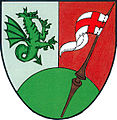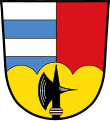Polearm (heraldry)
Polearms ( spears , lances , spears , pikes , pikes, and so on) are Heraldry common FIGS . The stylized representation of a polearm in a coat of arms sometimes prevents it from being clearly identified (e.g. a halberd is sometimes difficult to distinguish from a beard or a battle ax ). Therefore, the description of the coat of arms must specify which type of polearm is represented in the coat of arms. Although polearms are among the oldest human weapons and have undergone various developments over time, they are not as common as a heraldic figure as, for example, the sword .
presentation
Since the functions of polearms are very diverse (hunting, war, thrusting, throwing, tournament, presentation, directional weapons), numerous forms of representation of polearms can be found in heraldry (for example as a complete polearm, as a pole weapon tip, as Flagpole). All special attributes and shapes of a polearm must be reported. Often a polearm is held, pushed or thrown by an animal or human. Occasionally, polearms impale a living being or a thing or are depicted as a means of killing (for example in a hunting or war depiction). Polearms are shown individually, often in pairs and crossed or placed in a star-shaped group of three on top of each other, but they also occur in larger groups. All heraldic colors are possible for polearms. Polearms are particularly widespread in Polish heraldry .
When knights or horsemen are depicted in a coat of arms, they often hold a lance on which a stick with a piece of equipment is hung across ( "flagged lance" , see banner ).
meaning
The meanings of polearms in heraldry are just as varied as their functions. The polearm is often used in connection with Christian symbolism . For example, the halberd stands as a symbol for Matthew , the lance as a symbol for the Apostle Matthias or the Apostle Thomas or as an allusion to the Holy Lance , with which the death of Jesus was checked. Polearms are also attributes of saints and martyrs, such as St. George and St. Moritz . In general, polearms in heraldry are:
- a sign of secular and ecclesiastical power (for kings a spear is a symbol of the surrender of kingdom and land)
- a symbol of the lower nobility (the sword represents the high nobility)
- a legal symbol of the male principle ("spear" means "man / male tribe" in the older and legal language)
- a symbol for defense / army strength
- an allusion to a profession or activity such as hunter, soldier, forester ...
- Talking symbol for a family name like "Spieß" , "Stecher" , "Lanssenstill" , "Heer" ...
Gallery Speer
Golden spear and golden clearing hoe in an inclined intersection ( Grafrath )
Crossed spears / lances covered by a legionnaire's shield ( Vachendorf )
Friezes with spear ( Rüstringen (city) )
Warrior in right hand white spear with yellow shaft ( Menziken )
Crossed Heuliecher (hay hooks), which are often confused with spears ( Heubach ).
Gallery lance
Lance ( Schwadernau )
flagged lance ( Mnetěš )
Saint George with a lance ( St. Georgen in the Black Forest )
Lance ( coat of arms of the Szlachta )
Lanzenspitze ( Forchheim (Kaiserstuhl) )
Knight with a lance ( Siglingen )
Gallery halberd
Morning star and halberd, crossed: Alcove (Upper Austria)
Tongued bear holds halberd ( Haiming )
Crossed a broken lance and a halberd ( Hemmingstedt )
Halberd ( Mauth )
Woman with halberd ( Nordhastedt )
Armored Man with Halberd ( Roding )
Halberd ( Untereisesheim )
Halberd (coat of arms of the Baggehufwudt family )
Gallery skewer and others
various weapons in Hesedorf
Skewers in the coat of arms of the Manndorff family





















